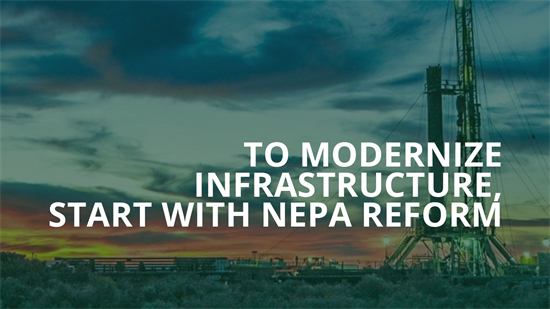BRANDED: To modernize infrastructure, start with NEPA reformBy Rep. David Schweikert (AZ-06)
Washington,
March 22, 2022
To modernize infrastructure, start with NEPA reform
By Rep. David Schweikert (AZ-05 Arizonans have felt the burden of America’s fraying energy infrastructure for decades. As a state located in the desert southwest, the highly variable environment places an emphasis on the need for modernized infrastructure and energy innovation. Heat waves often cause blackouts here at home, and in places like Texas and New York, we have seen the energy crisis hit especially hard. The best path forward is to reform the National Environmental Policy Act (NEPA), which continues to stifle progress and keep communities like ours in Arizona at a stalemate. President Richard Nixon signed NEPA into law in 1970 as a procedural statute instructing agencies to consider the environmental consequences of their actions. NEPA requires federal agencies to produce a cost–benefit analysis in the form of an Environmental Assessment (EA) or Environmental Impact Statement (EIS). Congress may have wanted to protect the environment, but we didn’t intend to create regulatory bloat that stifles innovation. A 1981 guidance document from the White House Council on Environmental Quality estimated that the NEPA process would take a maximum of one year. Unfortunately, environmental reviews are subject to frequent legal challenges that halt permitting for projects, generally on the dubious claim of insufficient analysis. To avoid this charge, agencies spend years writing environmental reports spanning multiple volumes, containing hundreds or even thousands of pages of analysis. According to estimates from the Competitive Enterprise Institute, federal regulations, such as those imposed by NEPA, can increase a new energy or infrastructure project’s cost by as much as 20 percent. In the fifty years since NEPA was signed into law, the process has become a bureaucratic nightmare. The latest data shows that completing an EIS takes an average of four and a half years, and a quarter of these statements take upwards of six years. Some projects drag on even longer: the approval process for a 12-mile expansion of Interstate 70 in Denver took 13 years to complete, with a final impact statement running 8,951 pages, not including an additional 7,307 pages of appendices. Before NEPA, projects could be completed quickly and efficiently. Congress authorized the damming of the Colorado River in 1928; construction began in 1931, and the Hoover Dam was opened five years later. Similarly, the federal government approved the Golden Gate Bridge in just seven months. The NEPA process would have rendered the swift completion of these projects impossible. Past reforms of the federal environmental review process have spurred innovation in the energy sector. In 2005, the Energy Policy Act was enacted, in part, to expedite oil and natural gas development by categorically excluding five types of oil and gas development activities from further NEPA analysis. Many in the oil industry credit these exclusions for expanding U.S. oil and gas extraction and increasing extraction efficiency, thereby reducing costs for consumers and furthering the pursuit of energy independence. NEPA can also have counterproductive environmental effects. In an earlier draft of the 2005 Energy Policy Act, geothermal energy was covered under these categorical exclusions. Unfortunately, geothermal was not included in the final version of the Act, though it shares similar operational effects as those of oil and gas production. If we extend the exclusion privilege to projects converting depleted oil and gas wells to geothermal energy sources, the U.S. can unleash more innovation and yield more abundant clean energy. Indeed, policymakers should streamline the environmental review process to allow for technological innovations in wind, solar, hydroelectric, and other renewable forms of energy and to provide for affordable and reliable power. Reducing NEPA’s overreach would deliver needed infrastructure improvements and clear the way for improved energy infrastructure, fewer power outages, and lower electricity costs. That’s why I have introduced two pieces of legislation that address NEPA’s ineffectiveness. The first is the NEPA State Assignment Expansion Act, which would let the federal government delegate NEPA review authority to relevant state entities. The states would then carry out the reviews under the supervision of NEPA. We know this system works because Arizona is one of seven states that currently have a NEPA Assignment agreement in place with the Department of Transportation, and our state has been able to work through the process efficiently and effectively. The second bill I introduced is the NEPA Accountability and Enforcement Act, which would expedite many of the burdensome delays the agency has caused. Specifically, this legislation requires federal agencies to complete the NEPA process in two years for proposed projects that need an EIS. It also imposes a one-year deadline to issue Categorical Exclusions and complete the entire NEPA process in a total of three years. Finally, it requires agencies to approve or deny permits within 90 days of completion of the NEPA process. Congress is allocating trillions of dollars to infrastructure solutions, but without regulatory reforms, these funds will be caught up in a labyrinth of bureaucratic delay. We can’t modernize our infrastructure without modernizing our regulatory process. Reforming NEPA is the place to start. David Schweikert, a Member of the Congressional Western Caucus, represents Arizona's 6th Congressional District. |
Stay Connected
Use the following link to sign up for our newsletter and get the latest news and updates directly to your inbox.


